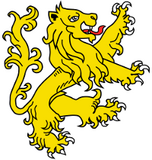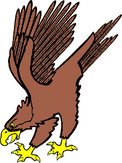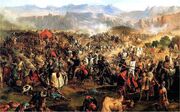m (→Afterwards: details as always...) Tag: sourceedit |
(Undo revision 1536865 by Chefe da Administração do Alternative History (talk)) |
||
| (19 intermediate revisions by 2 users not shown) | |||
| Line 1: | Line 1: | ||
| + | [[File:Lion_Rampant_(Of_Lions_and_Falcons).png|thumb|left|152px]] |
||
| − | {{WIP}} |
||
| + | [[File:Falcon_(Of_Lions_and_Falcons).png|thumb|122px]] |
||
| − | In 1212, the Christian armies of Navarre, Aragon and Castile defeated the Almohad army at the Battle of Las Navas de Tolosa, starting the true decline of Al-Andalus. By |
+ | In 1212 (609 AH), the Christian armies of Navarre, Aragon and Castile defeated the Almohad army at the Battle of Las Navas de Tolosa, starting the true decline of Al-Andalus. By 1340 (741 AH), it was reduced to the Emirate of Granada. But what if the Almohads had won? |
==Las Navas de Tolosa== |
==Las Navas de Tolosa== |
||
[[File:SlagBijNavasDeTolosa.jpg|thumb|left|The Battle of Las Navas de Tolosa]] |
[[File:SlagBijNavasDeTolosa.jpg|thumb|left|The Battle of Las Navas de Tolosa]] |
||
| − | On the 16 July of 1212 (15 Safar |
+ | On the 16 July of 1212 (15 Safar 609), the Almohad army and the joint army of Castile, Navarre, Aragon and Portugal and volunteers met near the Muslim population of Las Navas de Tolosa. Both armies knew that whoever won this war would be the one who decided if the [[Reconquista (Of Lions and Falcons)|Reconquista]] would continue or end there. |
| − | The Castilian army attacked first. Its army, made up of |
+ | The Castilian army attacked first. Its army, made up of 14.000 to 12,000 men, against the Almohad army consisting of approximately 22,000–30,000 men. Fighting on a proportion of 2:1, the Castilian army was quickly surrounded and destroyed. Most of the men died, about three hundred were taken as hostages, the Grand Master of the military order of Calatrava died in the initial assault. See [[Battle of Las Navas de Tolosa (Of Lions and Falcons)|Battle of Las Navas de Tolosa]]. Perhaps the most serious result was the death in the battlefield of Alfonso VIII of Castile. He was the main campaigner, promoter and organizer of this campaign. |
| + | |||
| + | Taking advantage of their triumph the Almohad army marched on to occupy Calatrava La Vieja ( Qal'at Rabah) and Malagon and years later the [[siege of Toledo (Of Lions and Falcons)|siege of Toledo]]. |
||
==Afterwards== |
==Afterwards== |
||
| − | The |
+ | The united Christian army was disbanded after that. Most Christians blamed each other for losing the war; Castile was specially targeted. The long standing rivalries of the Kingdom of Leon towards Castile came out and started several raids to recapture what it considered territory of theirs (([[Castilian-Leonese Wars (Of Lions and Falcons)|The Castilian-Leonese Wars]]). |
| + | |||
| ⚫ | The Almohads made their move, and in 1218 (614–615 AH) started a long overdue campaign to Castile. Soon, the frontier had been pushed back to the [[Tagus River (Of Lions and Falcons)|Tagus River]] and [[Toledo (Of Lions and Falcons)|Toledo]]. However the former glories and territorial conquests of {{W|Almanzor|Almanzor}} could not be repeated. The river Tagus became a long lasting frontier between Muslims and Christians. |
||
| + | |||
| + | {| class="article-table" |
||
| + | !So begins the '''[[First Book of Chronicles (Of Lions and Falcons)|First Book of Chronicles (XIII Century)]]''' |
||
| + | |} |
||
| + | See [[Reconquista (Of Lions and Falcons)|Reconquista]] |
||
| ⚫ | The Almohads made their move, and in |
||
| + | {{OfLionsAndFalcons}} |
||
| − | <!-- It was then that the population of Al-Andalus got tired of Almohad rule. They declared independence. The Almohad armies in Al-Andalus were usually pro-independence and by 1245, Al-Andalus was an independent nation. --> |
||
| − | [[Category: |
+ | [[Category:Of Lions and Falcons]] |
| + | [[Category:Timelines]] |
||
Revision as of 18:10, 8 April 2018


In 1212 (609 AH), the Christian armies of Navarre, Aragon and Castile defeated the Almohad army at the Battle of Las Navas de Tolosa, starting the true decline of Al-Andalus. By 1340 (741 AH), it was reduced to the Emirate of Granada. But what if the Almohads had won?

The Battle of Las Navas de Tolosa
On the 16 July of 1212 (15 Safar 609), the Almohad army and the joint army of Castile, Navarre, Aragon and Portugal and volunteers met near the Muslim population of Las Navas de Tolosa. Both armies knew that whoever won this war would be the one who decided if the Reconquista would continue or end there.
The Castilian army attacked first. Its army, made up of 14.000 to 12,000 men, against the Almohad army consisting of approximately 22,000–30,000 men. Fighting on a proportion of 2:1, the Castilian army was quickly surrounded and destroyed. Most of the men died, about three hundred were taken as hostages, the Grand Master of the military order of Calatrava died in the initial assault. See Battle of Las Navas de Tolosa. Perhaps the most serious result was the death in the battlefield of Alfonso VIII of Castile. He was the main campaigner, promoter and organizer of this campaign.
Taking advantage of their triumph the Almohad army marched on to occupy Calatrava La Vieja ( Qal'at Rabah) and Malagon and years later the siege of Toledo.
Afterwards
The united Christian army was disbanded after that. Most Christians blamed each other for losing the war; Castile was specially targeted. The long standing rivalries of the Kingdom of Leon towards Castile came out and started several raids to recapture what it considered territory of theirs ((The Castilian-Leonese Wars).
The Almohads made their move, and in 1218 (614–615 AH) started a long overdue campaign to Castile. Soon, the frontier had been pushed back to the Tagus River and Toledo. However the former glories and territorial conquests of Almanzor could not be repeated. The river Tagus became a long lasting frontier between Muslims and Christians.
| So begins the First Book of Chronicles (XIII Century) |
|---|
See Reconquista
| ||||||||||||||||||||


